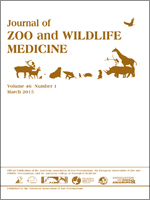Uropygial, or preen, glands are found in a variety of avian species including penguins. These glands have a multitude of functions and can develop a variety of conditions including impaction, rupture, adenitis, squamous metaplasia, and neoplasia of various types, with squamous cell carcinoma the most commonly reported. A case series of uropygial gland squamous cell carcinoma in five penguins at the Wildlife Conservation Society's Central Park Zoo is described. Most birds were aged (>10 yr) with a history of chronic, recurrent uropygial gland problems including impaction, rupture, abscess formation, or a combination of conditions. Before and after neoplasia diagnosis, these cases were managed conservatively, and palliative care was provided. Because many of these cases were preceded by chronic inflammation, it is possible this inflammation predisposed the uropygial gland to neoplastic transformation, and more aggressive treatment early in the disease process may therefore be warranted.
How to translate text using browser tools
1 March 2015
UROPYGIAL GLAND SQUAMOUS CELL CARCINOMA IN CHINSTRAP (PYGOSCELIS ANTARCTICUS) AND GENTOO (PYGOSCELIS PAPUA) PENGUINS AT THE WILDLIFE CONSERVATION SOCIETY'S CENTRAL PARK ZOO
Christy L. Rettenmund,
Alisa L. Newton,
Paul P. Calle
ACCESS THE FULL ARTICLE
neoplasia
penguin
Pygoscelis antarcticus
Pygoscelis papua
squamous cell carcinoma
uropygial gland





